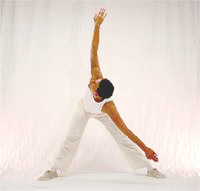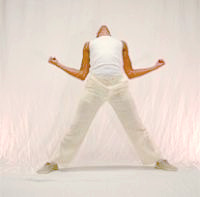|
|
WingTsun and
ChiKung – two sides
of the same coin |
 |
What can two so different systems as WingTsun and ChiKung have
in common? Or to put it differently: in terms of content, what
common denominator justifies them apart from the fact that they
are both offered by the EWTO?
WingTsun stands for highly efficient self-defence, and ChiKung
for comprehensive health with the emphasis on eliminating the
causes of chronic pain. Their content could hardly be wider
apart.
And yet there is a common content which forms the basis of both
systems, the martial art and the health system: the muscles and
the human movement apparatus.
By the time the
physical phase of a conflict has been reached, the muscles
become the motor of the movements we use to keep an attacker at
bay and put him out of action. The condition of these muscles is
a decisive factor. It determines the precision of these
movements – the decisive techniques – and the striking power we
use to hurt the opponent or even make him incapable of
continuing. A special form of muscle training takes place in
WingTsun, a fact not even known to most students. After a
certain time this muscular training gives WT people increasingly
supple movements and greater striking power. At master level it
is often the case that laymen and other martial artists who are
unaware of these effects react with surprise and even complete
incredulity to the suppleness and high speed of our movements,
as well as to the unexpected force of the striking energy.
This connection is immediately obvious in ChiKung.
Naturally, we know that the muscles are the active components in
the movement apparatus, so for this reason alone our muscles
have something to do with ChiKung.
But when speaking about health we normally
mean the absence of illnesses, so where is the connection with
the muscular system?
There certainly is one, and it exists on two different levels
which also have something to do with the effectiveness of this
health-promoting system.
The first concerns the pain therapy which our movements
represent. Yes, ChiKung is an individual, specifically applied
pain therapy. Understanding this requires knowledge which
general medical opinion unfortunately no longer possesses.
It concerns a fact generally accepted by WingTsun people, namely
that most painful conditions common today (and even chronic
conditions) are nothing but a cry for help by the body, as a
warning against damage to the relevant joint structures or the
spinal column as an agglomeration of numerous joints.
Arthritis,
a slipped disc and other damage only occurs if this warning is
ignored or suppressed by the use of painkillers. Since arthritis
itself cannot cause pain (cartilage does not contain any pain
receptors), the cause of the pain is eliminated if the dangerous
loads on the joint are avoided. We bring this effect about by
specifically retraining the muscles responsible for the pain,
for it is purely and simply incorrectly trained muscles that
cause the problematical loads on the joints which lead to wear
in the cartilage. The muscular condition that ensures the best
possible fighting ability in WingTsun is precisely the condition
that allows the joints involved in its movements to work with
minimum wear and tear. Or: the power that cannot be transferred
to the opponent because the muscles are working under friction
is exactly the same as that causing wear in the joints. The only
difference is that the range of movements in ChiKung is much
greater than in WingTsun, as it includes all the movements for
which our body is designed in order to make the joints function
without wear and tear. In WingTsun we logically restrict
ourselves to those movements that are important in combat.


|
|
Basic Chi-Kung
form - range of movements in ChiKung
is much
greater than in
WingTsun |
The second connection arises from the fact that the muscles are
linked to the entire body and the mind. All the internal organs
are stimulated by muscular activity, for example. If certain
movements are lacking, the organs only function to a limited
extent. In different terms: all unprocessed, negative emotions
are stored in the muscles in the form of tension. If we relieve
this tension by means of specific ChiKung movements, the
associated emotions are released to be process away and
eliminated as a problem. This psycho-therapeutic effect occurs
naturally, without any further effort. Like the first connection
described above, this also happens in WingTsun, but much more
intensively in ChiKung because the considerably wider range of
movements leads to much extensive muscular activity.
These inter-connections also explain why improved health is
already a tangible secondary benefit in WingTsun. The
health-promoting effects are already partially present, but are
limited by the necessary restriction to fighting movements. In
ChiKung, which is solely concerned with maximum health benefits,
the effects are brought about to the greatest possible extent.
Sifu
Roland Liebscher-Bracht,
5th
Master Level WT,
Chief Instructor WT-CK EWTO / IWTO
|


